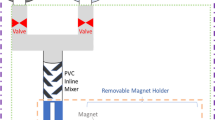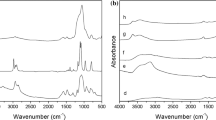Abstract
The sorption capacity of nanoporous titanosilicate Engelhard titanosilicate number 4 (ETS-4) and silica-coated magnetite particles derivatised with dithiocarbamate groups towards Hg(II) was evaluated and compared in spiked ultra-pure and spiked surface-river water, for different batch factors. In the former, and using a batch factor of 100 m3/kg and an initial Hg(II) concentrations matching the maximum allowed concentration in an effluent discharge, both materials achieve Hg(II) uptake efficiencies in excess of 99 % and a residual metal concentration lower than the guideline value for drinking water quality. For the surface-river water and the same initial concentration, the Hg(II) uptake efficiency of magnetite particles is outstanding, achieving the quality criteria established by the Water Framework Directive (concerning Hg concentration in surface waters) using a batch factor of 50 m3/kg, while the efficiency of ETS-4 is significantly inferior. The dissimilar sorbents’ Hg(II) removal efficiency is attributed to different uptake mechanisms. This study also highlights the importance of assessing the effective capacity of the sorbents under realistic conditions in order to achieve trustable results.




Similar content being viewed by others
References
Bai L, Hu H, Fu W, Wan J, Cheng X, Zhuge L, Xiong L, Chen Q (2011) Synthesis of a novel silica-supported dithiocarbamate adsorbent and its properties for the removal of heavy metal ions. J Hazard Mater 195(0):261–275. doi:10.1016/j.jhazmat.2011.08.038
Chen HR, Chen CC, Reddy AS, Chen CY, Li WR, Tseng MJ, Liu HT, Pan W, Maity JP, Atla SB (2011) Removal of mercury by foam fractionation using surfactin, a biosurfactant. Int J Mol Sci 12(11):8245–8258. doi:10.3390/ijms12118245
Council (1998) Council Directive 98/83/EC of 3 November 1998 on the quality of water intended for human consumption. Official Journal of the European Communities
Denizli A, Kesenci K, Arica Y, Piskin E (2000) Dithiocarbamate-incorporated monosize polystyrene microspheres for selective removal of mercury ions. Reactive & Functional Polymers 44 (3):235-243. doi:10.1016/s1381-5148(99)00099-1
European Parliament C (2000) Directive 2000/60/EC of the European Parliament and of the Council of 23 October 2000 establishing a framework for Community action in the field of water policy. Official Journal of the European Communities
European Parliament C (2001) Decision No 2455/2001/EC of the European Parliament and the Council of the European Union of 20 November 2001 establishing the list of priority substances in the field of water policy and amending Directive 2000/60/EC. Official Journal of the European Communities
European Parliament C (2008) Directive 2008/105/EC of the European Parliament and of the Council of 16 December 2008 on environmental quality standards in the field of water policy, amending and subsequently repealing Council Directives 82/176/EEC, 83/513/EEC, 84/156/EEC, 84/491/EEC, 86/280/EEC and amending Directive 2000/60/EC of the European Parliament and of the Council. Official Journal of the European Union
Figueira P, Lopes CB, Daniel-da-Silva AL, Pereira E, Duarte AC, Trindade T (2011) Removal of mercury (II) by dithiocarbamate surface functionalized magnetite particles: application to synthetic and natural spiked waters. Water Res 45(17):5773–5784. doi:10.1016/j.watres.2011.08.057
Ghasemi Z, Seif A, Ahmadi TS, Zargar B, Rashidi F, Rouzbahani GM (2012) Thermodynamic and kinetic studies for the adsorption of Hg(II) by nano-TiO2 from aqueous solution. Adv Powder Tech 23(2):148–156. doi:10.1016/j.apt.2011.01.004
Goubert-Renaudin S, Schneider R, Walcarius A (2007) Synthesis of new dithiocarbamate-based organosilanes for grafting on silica. Tetrahedron Letters 48(12):2113–2116. doi:10.1016/j.tetlet.2007.01.119
Hasan SH, Srivastava P (2009) Batch and continuous biosorption of Cu2+ by immobilized biomass of Arthrobacter sp. J Environ Manage 90(11):3313–3321. doi:10.1016/j.jenvman.2009.05.005
Ho YS, McKay G (1999) Pseudo-second order model for sorption processes. Process Biochem 34(5):451–465
Ho YS, Porter JF, McKay G (2002) Equilibrium isotherm studies for the sorption of divalent metal ions onto peat: copper, nickel and lead single component systems. Water Air Soil Pollut 141(1–4):1–33
Idris SA, Harvey SR, Gibson LT (2011) Selective extraction of mercury(II) from water samples using mercapto functionalised-MCM-41 and regeneration of the sorbent using microwave digestion. J Hazard Mater 193:171–176. doi:10.1016/j.jhazmat.2011.07.037
Imani S, Rezaei-Zarchi S, Hashemi M, Borna H, Javid A, Zand AM, Abarghouei HB (2011) Hg, Cd and Pb heavy metal bioremediation by Dunaliella alga. J Med Plants Res 5(13):2775–2780
Lagergren S (1898) Zur theorie der sogenannten adsorption gelöter stoffe. Kungliga Svenska Vetenskapsakademiens Handlingar 24(4):1–39
Lo SI, Chen PC, Huang CC, Chang HT (2012) Gold nanoparticle-aluminum oxide adsorbent for efficient removal of mercury species from natural waters. Environ Sci Technol 46(5):2724–2730. doi:10.1021/es203678v
Lopes CB, Otero M, Coimbra J, Pereira E, Rocha J, Lin Z, Duarte A (2007) Removal of low concentration Hg2+ from natural waters by microporous and layered titanosilicates. Microporous and Mesoporous Materials 103(1–3):325–332. doi:10.1016/j.micromeso.2007.02.025
Lopes CB, Otero M, Lin Z, Silva CM, Pereira E, Rocha J, Duarte AC (2010) Effect of pH and temperature on Hg(2+) water decontamination using ETS-4 titanosilicate. J Hazard Mater 175(1–3):439–444. doi:10.1016/j.jhazmat.2009.10.025
Lopes CB, Otero M, Lin Z, Silva CM, Rocha J, Pereira E, Duarte AC (2009) Removal of Hg(2+) ions from aqueous solution by ETS-4 microporous titanosilicate-Kinetic and equilibrium studies. Chem Eng J 151(1–3):247–254. doi:10.1016/j.cej.2009.02.035
Lopes CB, Pereira E, Lin Z, Pato P, Otero M, Silva CM, Rocha J, Duarte AC (2011) Fixed-bed removal of Hg(2+) from contaminated water by microporous titanosilicate ETS-4: experimental and theoretical breakthrough curves. Microporous and Mesoporous Materials 145(1–3):32–40. doi:10.1016/j.micromeso.2011.04.019
Lv JT, Luo L, Zhang J, Christie P, Zhang SZ (2012) Adsorption of mercury on lignin: combined surface complexation modeling and X-ray absorption spectroscopy studies. Environ Pollut 162:255–261. doi:10.1016/j.envpol.2011.11.012
Lv L, Tsoi G, Zhao XS (2004) Uptake equilibria and mechanisms of heavy metal ions on microporous titanosilicate ETS-10. Ind Eng Chem Res 43(24):7900–7906. doi:10.1021/ie0498044
Mahmoud ME, El-Essawi MM, Fathallah EMI (2004) Characterization of surface modification, thermal stability, and metal selectivity properties of silica gel phases–immobilized dithiocarbamate derivatives. J Liq Chromatogr Relat Technol 27(11):1711–1727. doi:10.1081/jlc-120037366
Marin ABP, Aguilar MI, Meseguer VF, Ortuno JF, Saez J, Llorens M (2009) Biosorption of chromium (III) by orange (Citrus cinensis) waste: batch and continuous studies. Chem Eng J 155(1–2):199–206. doi:10.1016/j.cej.2009.07.034
Ojea-Jimenez I, Lopez X, Arbiol J, Puntes V (2012) Citrate-coated gold nanoparticles as smart scavengers for mercury(II) removal from polluted waters. ACS Nano 6(3):2253–2260. doi:10.1021/nn204313a
Oliva J, De Pablo J, Cortina JL, Cama J, Ayora C (2011) Removal of cadmium, copper, nickel, cobalt and mercury from water by apatite II(TM): column experiments. J Hazard Mater 194:312–323. doi:10.1016/j.jhazmat.2011.07.104
Parham H, Zargar B, Shiralipour R (2012) Fast and efficient removal of mercury from water samples using magnetic iron oxide nanoparticles modified with 2-mercaptobenzothiazole. J Hazard Mater 205:94–100. doi:10.1016/j.jhazmat.2011.12.026
Rivas BL, Urbano B, Pooley SA, Bustos I, Escalona N (2012) Mercury and lead sorption properties of poly(ethyleneimine) coated onto silica gel. Polym Bull 68(6):1577–1588. doi:10.1007/s00289-011-0636-3
Roy PK, Rawat AS, Rai PK (2003) Synthesis characterisation and evaluation of polydithiocarbamate resin supported on macroreticular styrene-divinylbenzene copolymer for the removal of trace and heavy metal ions. Talanta 59(2):239–246. doi:10.1016/s0039-9140(02)00497-6
Say R, Birlik E, Erdemgil Z, Denizli A, Ersoz A (2008) Removal of mercury species with dithiocarbamate-anchored polymer/organosmectite composites. J Hazard Mater 150(3):560–564. doi:10.1016/j.jhazmat.2007.03.089
Tang H, Chang CY, Zhang LN (2011) Efficient adsorption of Hg2+ ions on chitin/cellulose composite membranes prepared via environmentally friendly pathway. Chem Eng J 173(3):689–697. doi:10.1016/j.cej.2011.07.045
Tang R, Li Q, Ding L, Cui H, Zhai JP (2012) Reactive sorption of mercury(II) on to poly(m-phenylenediamine) microparticles. Environ Technol 33(3):341–348. doi:10.1080/09593330.2011.572924
Umpleby RJ, Baxter SC, Chen YZ, Shah RN, Shimizu KD (2001) Characterization of molecularly imprinted polymers with the Langmuir–Freundlich isotherm. Anal Chem 73(19):4584–4591
Venkatesan KA, Srinivasan TG, Rao PRV (2002) Removal of complexed mercury from aqueous solutions using dithiocarbamate grafted on silica gel. Sep Sci Technol 37(6):1417–1429
Wang JL, Chen C (2009) Biosorbents for heavy metals removal and their future. Biotechnol Adv 27(2):195–226. doi:10.1016/j.biotechadv.2008.11.002
Acknowledgements
The authors thank Fundação para a Ciência e a Tecnologia (FCT; PTDC/CTM-NAN/120668/2010), FSE and POPH for funding. One of the authors, C.B. Lopes, thanks Fundação para a Ciência e Tecnologia (FCT) for a Post-Doc grant (SFRH/BPD/45156/2008). FCT and FEDER are also thanked financing projects PEst-C/MAR/LA0017/2011 and PEst-C/CTM/LA0011/2011.
Author information
Authors and Affiliations
Corresponding author
Additional information
Responsible editor: Céline Guéguen
Rights and permissions
About this article
Cite this article
Lopes, C.B., Figueira, P., Tavares, D.S. et al. Core–shell magnetite-silica dithiocarbamate-derivatised particles achieve the Water Framework Directive quality criteria for mercury in surface waters. Environ Sci Pollut Res 20, 5963–5974 (2013). https://doi.org/10.1007/s11356-013-1615-z
Received:
Accepted:
Published:
Issue Date:
DOI: https://doi.org/10.1007/s11356-013-1615-z




